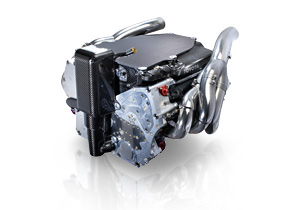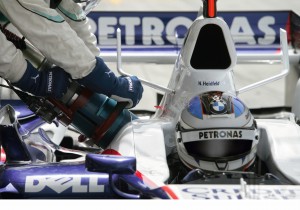 After the rumour, hype and, finally, launch of new American Formula One team, USF1, Bernie Ecclestone has suddenly remembered that he thinks he owns the trademark on ‘F1’ and has forced the team to change their name. USF1 will now be known as US Grand Prix Engineering or USGPE.
After the rumour, hype and, finally, launch of new American Formula One team, USF1, Bernie Ecclestone has suddenly remembered that he thinks he owns the trademark on ‘F1’ and has forced the team to change their name. USF1 will now be known as US Grand Prix Engineering or USGPE.
This is despite the fact that in 2007 the UK Trademark Registry refused to grant Formula One Licensing exclusive use of the term ‘F1’ as it considered it a generic term. In fact the only official trademark they own is ‘FIA Formula One World Championship’.
This is crazy. Aparently the fact that Bernie owned the trademark to ‘F1’ must have slipped his mind while he was helping the team get off the ground. He also doesn’t seem to mind other teams using ‘F1’ in their names; Williams Grand Prix Engineering goes under the trading name of WilliamsF1.
But Bernie didn’t stop there. Not content with going after teams that use ‘F1’ he also wants to own anything that might look like ‘F1’. It seems if you squint really hard the Force India ‘FI’ logo sort of looks a bit like ‘F1’. And of course Bernie owns that so it has to change.
Neither of these teams could afford any kind of legal challenge so they have little choice but to cave in to Ecclestone’s demands but this kind of thing does more harm to the F1 brand than good.
I’m not sure which is worse, Brawn Racing or USGPE…
February 24th, 2009
David
 The new engine rules for 2009 are set to be refined by the FIA to make it so teams cannot change an engine after the start of Saturday morning practice.
The new engine rules for 2009 are set to be refined by the FIA to make it so teams cannot change an engine after the start of Saturday morning practice.
The regulations aimed at cutting costs were announced in December last year and limit a driver to using no more than eight engines during a Championship season. Since then there has been some confusion as to when new engines may be used.
This latest change seems to go against FIA Race Director Charlie Whiting’s comments in a technical briefing last month which seemed to indicate he expected teams to change engines during an event:
What the teams will do is to have a Friday engine thatll probably do the first four races or something of that nature. Theyll then take the engine out and use another one for Saturday and Sunday.
The tweak to the regulations comes from a request from the teams. Renault’s engineering director Pat Symonds told Autosport.com:
All the teams I’ve spoken to feel that that’s a little bit against the way we’re trying to do things, and it will mean that you will have to take more people to the races. If we blew an engine on Saturday morning, of course we have enough people to change it. But we don’t have enough people to systematically change two engines, so we don’t really want that to be the case.
I guess this makes sense. There’s no point saving money on the number of engines used in a season if you just have to spend it again on engineers to replace two engines every weekend. It should also make it easier for fans to keep track of the state of the engines being raced. But it does go to show how every regulation will be exploited by the teams to the maximum extent.
I would like to see some kind of press release from the FIA that totally clarifies the 2009 engine regulations and the penalties that will be imposed. Maybe I’ve missed something but I’m still not entirely sure what will happen when a team uses a ninth engine. Surely they will only be penalised once and not for every race that they use the ninth engine. Will a penalty be applied for every new engine used after engine number eight?
The engine use rules are reasonably clear now but I think the engine penalty rules could use some further clarification.
February 11th, 2009
David
 BMW, Toyota and Ferrari must be wondering whether it was such a good idea to abandon Jerez to test at Bahrain’s Sakhir circuit.
BMW, Toyota and Ferrari must be wondering whether it was such a good idea to abandon Jerez to test at Bahrain’s Sakhir circuit.
Wednesday’s morning test session was red-flagged when a sandstorm prevented the medical helicopter from taking off. The same thing happened on the opening day of testing on Tuesday when the helicopter was grounded by fog.
After the first group test in Portimao was disrupted by heavy rain the three teams were hoping for some fine weather to justify the hundreds of thousands of pounds extra it costs to test in the Middle East but the outlook for the rest of Wednesday doesn’t look good. Even if the wind stops the track will have to be cleared of sand so the teams might not be able to continue testing until Thursday.
Meanwhile, back in Spain, Mark Webber has climbed into an F1 car for the first time since breaking his leg in a cycling accident three months ago. He took the new Red Bull RB5 out onto the Jerez circuit for the first time on Wednedsay.
Image: Ferrari S.p.a.
 In a meeting on Tuesday, the Formula One Teams’ Association (FOTA) continued discussions on how to reduce costs in F1. One of the ideas proposed was the scrapping of refueling.
In a meeting on Tuesday, the Formula One Teams’ Association (FOTA) continued discussions on how to reduce costs in F1. One of the ideas proposed was the scrapping of refueling.
the FIA wants the cost of competing in Formula One to fall to less than 100m for manufacturer backed teams and 50m for the independent teams. Last year Toyota spent over 300m on their F1 team.
FOTA have already agreed that manufacturers will supply cheap engines to independent teams in 2010 but in a white paper seen by the Financial Times the FIA want to define a limited number of areas where teams can compete in development. Areas such as engine, gearbox and suspension would be designated as “non-compete”. In the article , Ron Dennis sounds a warning about increasing standardisation:
F1 should not be a prescriptive formula where engines and a large group of components should be standard. That places total emphasis on the driver, and if you went down that route the drivers would be the [important] ingredient and that is where the money would be spent.
I couldn’t agree more. It might sound appealing at first to have nearly identical cars with the only variable being the driver but this isn’t what Formula One is about. Yes, costs should be reduced where possible to allow independent teams to take part, but if F1 moves towards becoming another spec-series it would lose its special appeal. Furthermore, as Ron says, if the only thing teams could spend money on was the driver then they would just shift large portions of their budgets from car development to driver salaries.
As far as banning refueling goes I’m not so sure. It was introduced in 1994 and I do think it adds to the show. It also encourages different race strategies. I’m not sure how banning it would reduce costs as all teams use a standard refueling rig anyway. The only real argument for banning it would be on safety grounds but surely the Grand Prix Drivers’ Association would have raised this if safety was an issue?
 In a technical briefing published on the FIA website, FIA Formula One Race Director,Charlie Whiting, has clarified the new engine rules for 2009.
In a technical briefing published on the FIA website, FIA Formula One Race Director,Charlie Whiting, has clarified the new engine rules for 2009.
There has been some confusion over the new regulations as previously “Each driver may use no more than one engine for two consecutive Events in which his team competes.”, but the new rules specify only a limit of eight engines to be used during the entire season and mention nothing about consective races.
In the briefing Whiting says:
Its eight engines for the whole year. A driver will only incur a penalty if he uses a ninth engine. So the teams can use the engines as they like. Theres no three consecutive race rule because there doesnt seem to be a need for it any longer. The engines will not have to do three complete events now.
In the past, as you know, the two-race engine was used only on Saturdays and Sundays. Now, for 17 races, the eight engines will have to do the three days of each grand prix. What the teams will do is to have a Friday engine thatll probably do the first four races or something of that nature. Theyll then take the engine out and use another one for Saturday and Sunday. All weve got to do, – itll be extra work – is to make sure that these engines remain sealed and are untouched.
So teams will be able to change engines whenever they wish, including during an event. What still isn’t clear is if a driver uses a ninth engine will he be penalised for the rest of the season or only at the next race?
 After the rumour, hype and, finally, launch of new American Formula One team, USF1, Bernie Ecclestone has suddenly remembered that he thinks he owns the trademark on ‘F1’ and has forced the team to change their name. USF1 will now be known as US Grand Prix Engineering or USGPE.
After the rumour, hype and, finally, launch of new American Formula One team, USF1, Bernie Ecclestone has suddenly remembered that he thinks he owns the trademark on ‘F1’ and has forced the team to change their name. USF1 will now be known as US Grand Prix Engineering or USGPE. The
The  BMW, Toyota and Ferrari must be wondering whether it was such a good idea to abandon Jerez to test at Bahrain’s Sakhir circuit.
BMW, Toyota and Ferrari must be wondering whether it was such a good idea to abandon Jerez to test at Bahrain’s Sakhir circuit. In a meeting on Tuesday, the Formula One Teams’ Association (FOTA) continued discussions on how to reduce costs in F1. One of the ideas proposed was the scrapping of refueling.
In a meeting on Tuesday, the Formula One Teams’ Association (FOTA) continued discussions on how to reduce costs in F1. One of the ideas proposed was the scrapping of refueling.